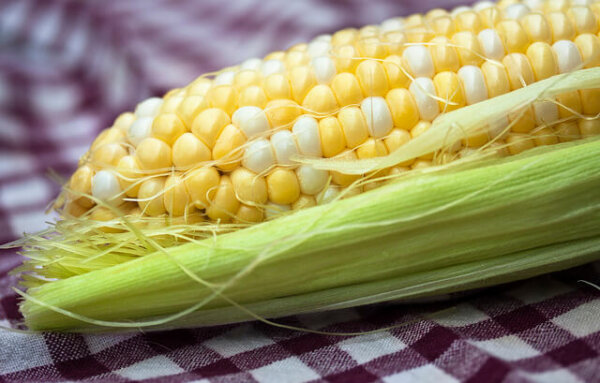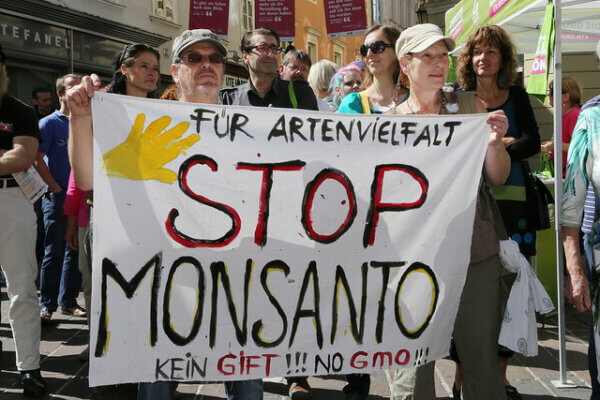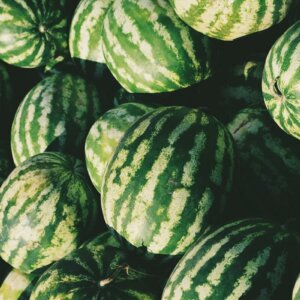The first time I heard the phrase “GMO” was at a rally, and I had to ask my 9th-grade science teacher what it meant. That was before ballot initiatives demanding GMO labelling and before Non-GMO Project logos became familiar on food labels.
Since then, awareness about GMOs has increased dramatically. It is an issue that polarizes people and causes strong emotions that sometimes overrule logic and scientific data. My friend’s four-year-old will tell you that GMOs are bad to eat.
But what are GMOs actually? Why are they so bad?
The Science of GMOs
GMO stands for Genetically Modified Organism, and it refers to any plant or animal that has had foreign DNA inserted into its genome.
That’s all I knew about GMOs until college when a very annoyed professor explained the process in more detail. She was tired of people talking about GMOs without understanding the science of the process.

Plant Breeding – “Natural” Genetic Change
To be clear, humans have been altering the genetic make-up of plant and animal populations for hundreds of thousands of years, through selective breeding, but genetic engineering is not the same at all.
Breeding makes use of genetic mutations that occur naturally and randomly in plants. Breeders encourage a particular mutation, like larger fruit, by crossing plants which display the desired trait. However, plant breeders have to wait for a desired trait to occur in one plant before they can select for it. That is the reason that, despite decades of breeding, there are no truly black roses. That particular pigmentation simply does not exist to be selected for.
By contrast, true genetic engineering essentially causes the desired mutation, by inserting it into the gene sequence. However, even genetic engineering cannot produce just any result. The effectiveness and versatility is limited by the scientific process.
Modern Genetic Engineering and Modification
Let’s review basic cellular biology first. All our cellular activity is carried out by enzymes—short chains of amino acids. Enzymes control the activity, called “expression,” of our DNA. Every cell in our body, or in a plant, contains a full strand of DNA in the cellular nucleus. But only part of that DNA is being used in each cell. That’s why blood cells are different than brain cells and so on. Enzymes make that possible by “folding” and “unfolding” DNA, so that only the necessary parts are “readable” in any particular cell. Enzymes also cut and duplicate DNA when necessary, which makes them the natural tools for working with DNA.
Scientists and bioengineers use enzymes to slice a particular section of DNA out of one organism. Then there are a number of ways to get it into another organism. It can be done mechanically through microinjection, but more commonly, scientists use a virus or bacteria as a carrier.
Viruses and bacteria are ideal vectors for carrying new DNA into an organism, because their method of reproduction naturally includes DNA transfers. Because they reproduce assexually, they need a different way to get genetic variety in their populations. So viruses and bacteria swap “packets” of genes called plasmids. Plasmid transfers introduce genetic diversity to a population of bacteria or viruses.
Researchers working on developing GM crops use the natural ability of those simple organisms to transfer short strands of DNA into embryonic seeds. Once inserted, the DNA becomes seamlessly incorporated into the rest of the host plant’s DNA. When the plant reproduces, it carries the new DNA in its seeds.
For more information on the science of GMOs, check out this video from popular internet science geek, Hank Green. He presents a balanced and upbeat overview of the science and background of GMOS.
DNA is naturally flexible and adaptive. The diverse biological history of Earth tells us that, loud and clear. There is nothing unprecedented about DNA mutating, swapping, breaking, recombining or changing in any way. However, having a human hand in the process makes many people uncomfortable.
The History of GMOs
Research in genetic engineering started producing GMOs in the 1970s, but the first GM (genetically modified) food didn’t hit the grocery stores until 1992. The first GM food available, a tomato variety called Flavr Savr, aroused suspicion and distrust from the public. It was a commercial failure. Two years later, in 1994, the FDA approved Monsanto’s Roundup-Ready corn, and the age of GMOs was born.
The active ingredient in Roundup is a chemical herbicide called glyphosate, which kills most plants, including corn, and is toxic to other organisms. Bioengineers at Monsanto used DNA from a bacteria that is resistant to glyphosate and added it to the genome of their field corn. Roundup-Ready corn crops can be sprayed with glyphosate to kill weeds without harming the desirable crop.
Roundup-Ready crops have become king in conventional fields around the world. 88% of America’s largest crop, corn, is Roundup-Ready, as is 93% of soy planted in the US. It’s no coincidence that the leading name in GM research and the developer of glyphosate resistant corn is also the producer of Roundup: Monsanto.
Who is Monsanto?
If we talk about GMOs, we have to talk about Monsanto. The name Monsanto has become so closely intertwined with GMOs that sometimes the two are used interchangeably. However, combining the words is misleading, at best. Monsanto is first and foremost a chemical manufacturer and in their long history have produced chemicals for a variety of industrial purposes, including Agent Orange and DDT. Currently they are a major producer of pesticides like Roundup and other agricultural chemicals, and they have become a leading researcher in agricultural biotechnology.
Monsanto’s corporate practices have made them a target of hatred and fear from the public. But they are not the only company which produces GM seeds—Syngenta and DowDupont are Monsanto’s major competitors. Nor are they the only company with a track record of environmental destruction.

Monsanto has suffered a history of PR crises, but the biggest began in 1998 when the company sued a Canadian canola farmer for having patented seed on his property without paying. He claimed that he had not planted the seed, but it had blown onto his farm.
Monsanto won the case in the courts, but lost it decisively in the court of public opinion. Despite the public backlash, they have gone on to sue more farmers who save their patented seed, or have their fields contaminated.
Ultimately, the public hatred for Monsanto is linked to more than just their exploitive corporate practices and environmental abuses. It comes from fear for our health, our families, our planet, and our food. Monsanto is a visible and unpopular target.
Concerns about GMOs
Only a handful of GM crops are approved to be grown in the US, but those include some of the most common additives to processed foods, like corn, soy, canola, potatoes, and sugar beets, which is used to produce refined sugar. Unlike the ill-fated Flavr Savr tomato, most GMOs do not arrive directly on our plates, but are part of the production of the food we eat. Non-organic meat animals have eaten GM corn and soy all their lives. Corn syrup and fructose in processed foods and sodas are made from GM corn and sugar beets. Potato chips, french fries, and donuts have likely been fried in oil from GM soy or canola. As GMOs become more common in food we eat every day, we increasingly wonder: is GM food safe to eat and safe to grow?
Concern #1: Do GMO Foods Harm Our Bodies?
We all want to eat food that is safe and nourishing. How do GMOs affect our bodies and our health? Some opponents of GMOs point to a 2012 study which linked GMO consumption to reproductive problems in rats, but that study has since been retracted. There is no reliable evidence that GM foods have any impact on your body.
Of course, other factors are involved too. The power of our own perceptions is not to be underestimated. When I worry that a food is not good for my body, I don’t feel good after eating it, regardless of the actual nutritional content of the food.
And finally, since USDA organic standards forbid the use of GM seeds, all GMOs are conventional crops, sprayed with conventional pesticides and fertilizer. So if you are trying to avoid food that has been treated with pesticides, for personal or environmental reasons, you will also be avoiding GMOs.
Concern #2: Do GMO Foods Increase Pesticide Use?
Most GM crops fall into two broad categories: herbicide tolerant and Bt. Herbicide tolerant GMOs are like Roundup-Ready. They are designed to be immune to pesticides that kill other weeds. Bt, on the other hand, has a gene sequence from the bacteria Bacillus thuringiensis. Bt produces a protein toxic to a number of worms and insects that attack crops, including the European Corn Borer.
Since the invention of Bt corn and cotton, advocates claim that GMOs lead to using fewer pesticides, but studies show the opposite. Fields growing Bt crops do in fact use fewer herbicides, but the benefits are outweighed by the increased use of the other category of GMOs. GM crops like Roundup-Ready corn, soy and canola lead to an increase, not a decrease, in pesticide use.
Also, selection pressure from frequent use of Roundup has produced a new generation of glyphosate-resistant weeds. In response, conventional farmers mix more than one type of herbicide, but this backfires. It leads to weed populations with resistance to multiple chemical poisons. Clearly, this is a serious environmental concern. Using pesticides is also a health and justice issue for farm workers, who have to spray them.
Benefits of GMOs
Despite these problems, which are serious and frightening, there are some benefits coming from genetically modified food. It’s not just for-profit corporations producing GM seeds. Many institutions including universities around the world develop and produce GM crops.
Benefit #1: GMOs May Prevent Starvation
Researchers hope that GM seeds can save lives. Intensive research at Oxford and elsewhere is aimed at producing GM rice that could tolerate extreme drought. Other researchers are developing GM seeds that are resistant to funguses and diseases that devastate crops. In a world with a growing population and an increasingly unstable climate, GMOs could possibly prevent massive starvation.
Benefit #2: GMOs May Help Farmers Stay Profitable
Closer to home, many conventional farmers have benefited financially from growing GM crops. Genetic modification has increased yields in commodity crops like corn, soy and cotton. In our industrial food system it is easy to forget that although most farms are massive (the average farm size today according to the USDA is 1105 acres) nearly all of those farms—96%—are owned and operated by a single family. Many of those families are struggling to make ends meet. The USDA estimates that 69.3% of all farms have a profit margin of less than 10%.
Farms are complex and challenging systems involving tradeoffs between labor, mechanization, and pesticide use. GM crops are another tool in a farmer’s toolbox in the fight to protect their profit margin. Like other options available to farmers, GMOs involve challenging tradeoffs between benefits and drawbacks.
GMOs: No Easy Answers
The issue of GM food is complex and polarized. Genetic modification is a tool that may hold hope for reducing hunger in an uncertain future, but which has been exploited by corporations for profit. There is no evidence that GMOs hurt human bodies, but they may be having a negative impact on the environment.
This spring, my partner and I wanted to plant a trial of heirloom corn to seed-save. Since corn is wind-pollinated, it needs a buffer of around half a mile to prevent cross-contamination, if you want to save the seeds. We visited our neighbors and offered to give them the seed we were growing to plant instead of the varieties they normally grew, so we could have a clean crop. Most people were happy to, but one neighbor, not to put too fine a point on it, refused. He had been planting Roundup-Ready corn for two decades, and wasn’t about to change for a couple of kids like us. He liked how he grew corn (read: with pesticides) and wasn’t about to start (weeding) new crops. GMOs were part of a lifestyle for him. Sadly, my partner and I shelved the corn breeding project.
There are no easy answers. Personally, I am excited about the possibility of GMOs helping prevent famine in the event of disease and drought. I want to see that research better funded and to see the findings implemented. However, in my daily life I mostly choose to avoid eating foods containing GM ingredients because of the many other problems with the industrial food system, including pesticide use, abuse of workers, and lack of transparency.
The fear and anxiety over GMOs are part of more complicated issues. We live in a rapidly consolidating and increasingly opaque food system. We feel helpless to protect ourselves and our families from any number of problems—from obesity to cancer—that are linked to our foods. We distrust large corporations and yet find ourselves increasingly surrounded by them. We feel unheard and unsafe. GMOs are part of that story, but only part. As consumers and gardeners we can educate ourselves and make informed choices about what feels best for our bodies and our families. We can share our new knowledge with our friends and our local legislators. We can support funding for the EPA, USDA, and third party regulators. We can introduce and campaign for legislation opposing monopoly and corporate power. We can insist on being heard.










































There are more problems with GMO/Transgenic organisms/crops than just the excessive use of pesticides/herbicides. Transgenic produced food supplement L-tryptophan was proven to be responsible for hundreds of human deaths and thousands of serious illnesses which also illustrated the very complex nature of making the connection to to the GMO culprit. Thus our FDA / USDA exempting GMO foods from required testing through politically corrupt channels of persuasion is highly suspect. Further, the scientists and studies that have found concerns have been attacked and vilified rather than researched.
There is no question that disease and illnesses are rising extremely and that the biggest culprit is likely industrial food, How much harm from the GMO technology is a big question! And that’s the problem…we do know, however, that working with natural systems and employing true sustainable agricultural systems, such as organic methods, can improve human AND environmental health now and into the future!!